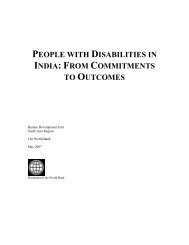FREE Download - TARSHI
FREE Download - TARSHI
FREE Download - TARSHI
Create successful ePaper yourself
Turn your PDF publications into a flip-book with our unique Google optimized e-Paper software.
Transition to Modernism?<br />
Interestingly, several of the studies (eg. Allahbadia, 1990; Sachdeva, 1997; Sodhi, 2000) comment on<br />
changes in Indian society and the transition from tradition to modernism and attribute this to the<br />
influence of television. However, they make this claim without substantiating it. Savara (1994) also links<br />
growing urbanisation and consumerism to freer social relationships. While discussing the cultural<br />
context, Savara's claim that there is a positive attitude towards sexuality in India contradicts what other<br />
researchers have found. Abraham (2000), Khan, (1996) and Khanna et al (2000), for example, found<br />
that patriarchal values are prevalent and that they suppress expression of sexual autonomy.<br />
V. METHODOLOGICAL AND<br />
ETHICAL ISSUES<br />
Methodological Issues<br />
Much of the earlier research on sexuality in India relied on quantitative approaches such as surveys of<br />
knowledge, attitude and practices (KAP). When conducted well, this approach can provide valuable<br />
information about sexual behaviour and the knowledge of sexual health and illnesses. Comparative<br />
surveys can usefully show differences between socio-cultural groups, men and women, people of<br />
different ages and those from different geographical areas. There has been a major shift in approach in<br />
the last ten years. More qualitative and participatory research approaches have been used, especially<br />
in the latter part of the decade. These approaches provide an understanding of the perceptions and<br />
beliefs about and the meanings that people give to sexuality, and of how these interact with<br />
socio-economic factors and with gendered power structures to result in particular sexual behaviours,<br />
norms, values and identities.<br />
Almost half of the studies reviewed here have used a qualitative approach. Of the rest, thirty percent<br />
have used quantitative methods (surveys using structured questionnaires/interviews), and the remaining<br />
twenty percent, a combination of quantitative and qualitative approaches. This critique distinguishes<br />
between qualitative and quantitative methodologies - that include the theoretical frameworks and values<br />
on which the research process is based, and, specific methods and tools such as surveys and in-depth<br />
interviews. This section of the review outlines some general issues pertaining to research methodology<br />
before moving on to reviewing the qualitative and quantitative methodologies used in the<br />
studies reviewed.<br />
Research Team<br />
Few studies have specified who the research team or the field investigators were or what their training<br />
and preparation for gathering data about sensitive issues of sexuality comprised of. In some studies,<br />
individuals who were in regular contact with the researched group (either as health care providers or<br />
street educators) were trained to communicate about issues related to sexuality, and they also formed<br />
part of the research team (Amin et al, 1996; Khanna et al., 2000; Sodhi, 2000; Ubale et al., 1997).<br />
Khanna et al also trained health workers to deal with participants' feelings in the context of researching<br />
12










